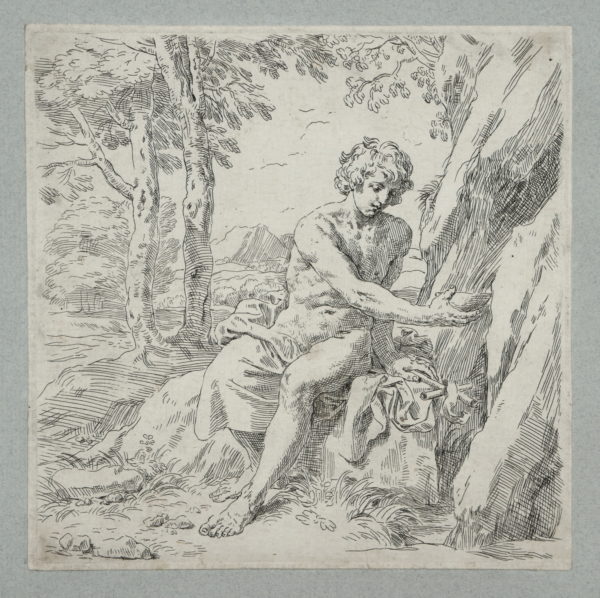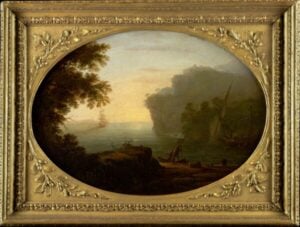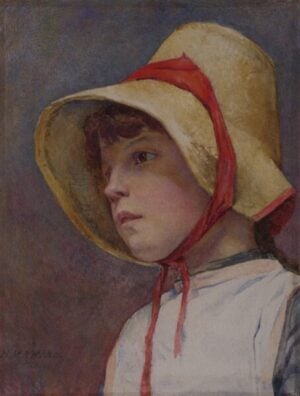Cantarini, Simone (Italian, 1612-1648)
Simone Cantarini was born in 1612 in Pesaro, in the Marches, a region which was a crossroads for artists from many parts of Italy. He began his artistic training quite young, probably 1623-1625, in the studio of Giovanni Giacomo Pandolfi (?1570-1640?), a painter of religious works who combined the local naturalism with the mannerist style of the late sixteenth century. After a brief trip to Venice, Cantarini moved to the shop of Claudio Ridolfi (?1570-1644), a student of Paolo Veronese (1528-1588). From Ridolfi he received training in the Venetian manner that was also a strong current in the local tradition, as well as a deep appreciation for the art of Federico Barocci (1535-1612), with whom Ridolfi had worked in Urbino. In about 1629 Ridolfi left Pesaro, forcing Cantarini to continue his studies on his own. In addition to prints by the Carracci, the young artist turned his attention increasingly to Barrocci and also to the Caravaggesque, yet very personal, art of Orazio Gentileschi, who executed several works in the Marches during the 1610s, and of Giovan Francesco Guerrieri (1589-1657) from nearby Fossombrone.
As Malvasia recounts (see person bibliography), the most significant event of Cantarini's youth was the arrival, probably in 1632, of Guido Reni's (1575-1642) Madonna and Child with Saints Thomas and Jerome in Pesaro Cathedral (now Pinacoteca Vaticana). Not content to study Guido's style from this work alone, Cantarini went to the church of San Pietro in Valle in nearby Fano to copy and draw after Guido's Giving of the Keys to Peter (now Louvre, Paris), completed 1626, and Annunciation of 1620-21. The young artist quickly assimilated Guido's style and soon received important commissions, including the Saint Peter Curing a Lame Man for San Pietro in Valle. Malvasia writes that while visitors might mistake this for a work of Guido, Cantarini himself felt that it lacked a "certain Renian grandeur and nobility." Cantarini's desire to go to Bologna to study in Guido's studio was given additional impetus by an attempt on his life resulting from amorous exploits, which, Malvasia intimates, were inspired by a too careful study of the lascivious prints by the Carracci.
Upon his arrival in Bologna, probably in 1634 or 1635, Cantarini presented himself in Guido's studio as a painter of little training. His abilities soon became evident. Although Guido recognized that Cantarini was already a fully formed painter, he made the young man his most trusted pupil and secured him many commissions. Eventually, however, Cantarini's infamous pride and unbridled tongue came to the fore and alienated the master and the entire studio. One point of friction was Cantarini's refusal to use his considerable talents as an etcher to propagate Guido's designs, claiming that his own were equally worthy of publication. The decisive break came in 1637 when Cantarini publicly repudiated Guido's relatively minor criticism of his Transfiguration for the Barberini church at Fortezza Urbana (now Brera, Milan). From this point on, Cantarini's relations with his patrons also deteriorated rapidly, to the point where his commissions fell off almost entirely.
In 1639 Cantarini is documented at his sister's wedding in Pesaro. It must have been shortly thereafter, in 1640 or 1641, that he made a brief trip to Rome. Following Guido's death in 1642, Cantarini returned to Bologna, where he maintained a successful studio until his death in 1648 following a stay in Mantua. His behaviour and criticisms of the Gonzaga collection created a scandal and it is suspected that he was poisoned by an angry rival.



